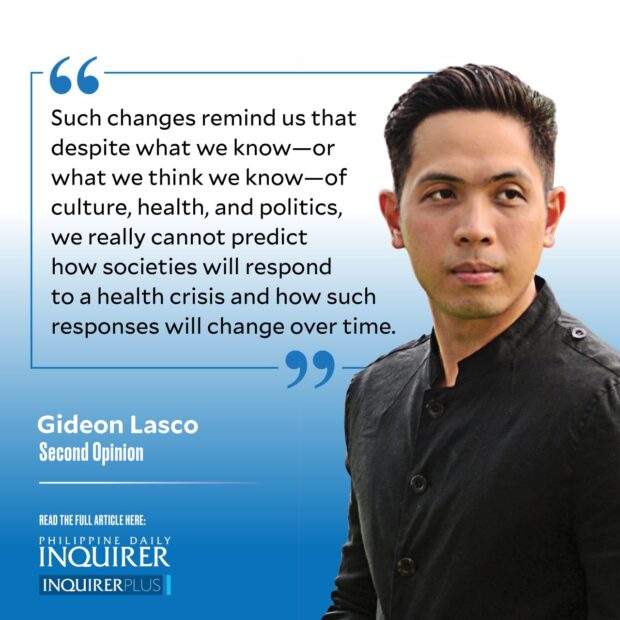Japan’s hygiene culture, revisited
Tokyo, Japan—Over the years, I have written a number of columns from and about Japan, and during a visit in October 2019, I wrote about its hygiene culture (“Technologies of the hygienic self,” 10/24/19), referencing “trains and subways [where] it is not uncommon to see people wearing face masks,” “pads you can use to cover the toilet bowl so your skin won’t come into contact with the same surface that others have sat on,” and “fitness centers [where] people who work out are provided with a small piece of cloth and a spray to clean the machines as soon as they’re done with each of them.” Attributing all of the above to “Shinto notions of pollution and purity” and “different purposes other than hygiene,” I concluded by asking: “As I continue my travels, I wonder: How will the hygienic practices in Japan—and the rest of the world—look like in the years and decades to come?”
Little did I know that just months later, a pandemic would radically alter hygiene practices at a global scale, allowing us to revisit the question much sooner than expected.
Article continues after this advertisementUnlike a few other countries, for which I made observations in this space, I was not able to visit Japan during the peak of the pandemic. Nonetheless, my two relatively late visits—from February to March this year and this ongoing week-long trip—allowed me not just to see Japan anew but also talk to my friends and colleagues who lived through COVID-19 here.
Actually, even in 2020, Japan’s pandemic response has been much discussed all over the world, with gaijin and Japanese politicians alike touting what then Prime Minister Shinzo Abe called the “Japan model.” Indeed, after just two months Abe lifted the initial emergency and classes resumed in Japan after just three months (even then, educators lamented the “disaster for children” that ensued). This model—accomplished even when virtually all of the guidelines were purely voluntary—has been typically explained as a combination of cultural values like conformity and cleanliness (e.g., the hygiene practices that I described even before COVID) as well as a robust health infrastructure.
One important component of this model was the avoidance of “three Cs” (3密),—closed spaces (密閉), crowded places (密集), and close-contact settings (密接)—that anticipated the outdoor paradigm that many countries were slow to embrace.
Article continues after this advertisementThe government’s declarations of victory in 2020 did not prevent COVID-19 surges in the coming years, especially with the coming of more contagious variants. Its vaccine rollout had a rocky start; by August 2021, even Haruki Murakami was criticizing then Prime Minister Yoshihide Suga’s optimistic outlook. A month before, Japan was able to push through with the Tokyo Olympics and despite its aging population, it actually managed to have one of the lowest COVID-19 death rates in the world by the end of 2021. However, more recent analyses from the National Institute of Infectious Diseases suggest that the country had excess deaths of up to 113,000, possibly due to Omicron’s impact on the elderly: A reminder that our judgments about “success” or “failure” are at best tentative.
Japan was not exempt from hygiene theater. Those who were able to attend the Olympic Games, for instance, complained of “oversanitization”; and plastic barriers abound today in cafés and conference rooms, notwithstanding the fact that since 2021 their efficacy has been largely disproven. My Tokyo-based hiking buddy Jeion Paguio shares that they had their share of antivaxxers and antimaskers, too; while small in number, they belie simplistic notions of homogeneity and conformity that many associate with this country.
Perhaps because of its people’s love for nature—yet another notable cultural value—people were never barred from going outdoors and climbing mountains. Even today, the ease of access of Japan’s hiking trails is what has drawn me to a lifelong quest—I’m now at 35 percent—to climb its “100 Famous Mountains” (日本百名山). We will do well to embrace this ethos, seeing nature not as a place of risk or danger but as a place of healing, enjoyment, and enlightenment. And not as an optional afterthought but as a necessary part of people’s lives.
Remarkably, even though my two visits are only several weeks apart, I already see significant changes in people’s practices. Making my way out of Haneda Airport back in February, I had to reach for my face mask upon realizing that I was the only one not wearing one in the Tokyo Monorail. While most still wear masks inside buses and trains today, a significant proportion don’t.
Such changes remind us that despite what we know—or what we think we know—of culture, health, and politics, we really cannot predict how societies will respond to a health crisis and how such responses will change over time.
—————-
glasco@inquirer.com.ph

















